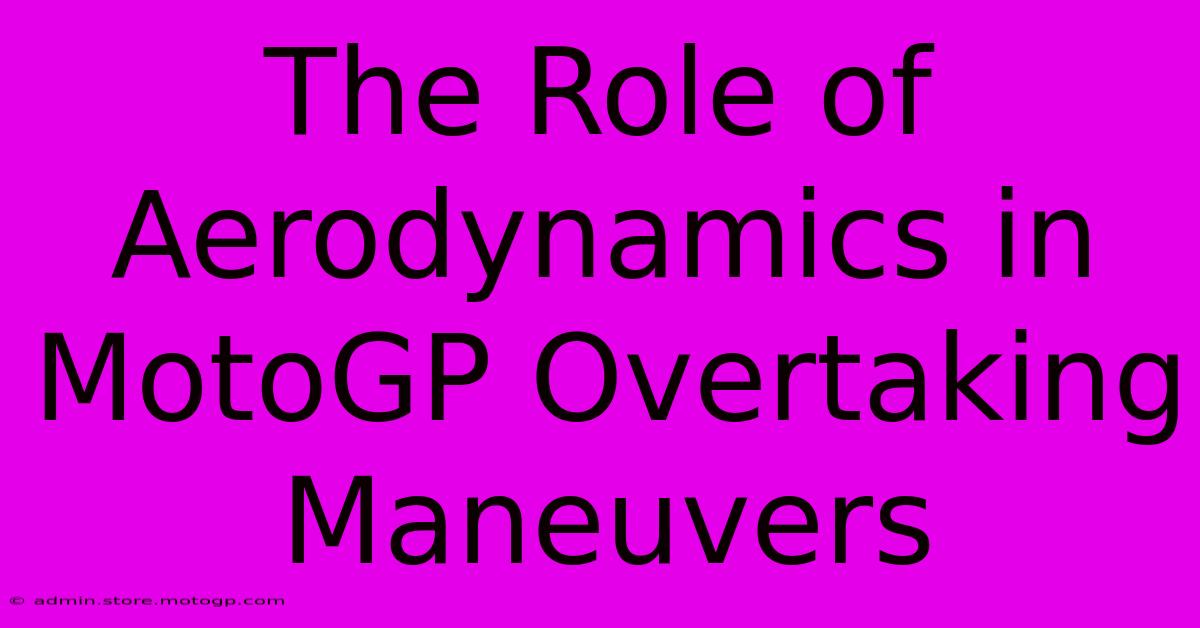The Role Of Aerodynamics In MotoGP Overtaking Maneuvers

Table of Contents
The Role of Aerodynamics in MotoGP Overtaking Maneuvers
MotoGP racing is a thrilling spectacle of speed, skill, and strategy. Overtaking, a crucial element of the sport, is often decided by razor-thin margins. While rider skill and engine power are undeniably important, the often-overlooked role of aerodynamics plays a surprisingly significant part in successful overtaking maneuvers. This article delves into the intricate relationship between aerodynamics and overtaking in MotoGP.
Understanding Aerodynamic Forces in MotoGP
Before we explore overtaking, understanding the fundamental aerodynamic forces at play is crucial. MotoGP bikes generate downforce, pushing them firmly onto the track, enhancing grip and stability at high speeds. This downforce is primarily created by aerodynamic components like:
- Fairings: The sculpted bodywork channels airflow, generating downforce and reducing drag.
- Wings: These aerodynamic appendages, especially prominent in recent years, generate significant downforce, particularly at high speeds.
- Spoiler: Positioned at the rear, the spoiler manages airflow separation, minimizing drag and enhancing stability.
These components work in concert to create a stable platform for the rider, allowing for precise control and enabling aggressive maneuvers during overtaking attempts.
The Aerodynamic Impact on Overtaking
Aerodynamics influence overtaking in several key ways:
-
Slipstream: Riding closely behind another bike reduces the air resistance experienced by the following rider. This allows them to significantly increase speed, giving them a crucial advantage when attempting to overtake. Utilizing the slipstream effectively is a key skill among top MotoGP riders. They carefully manage their positioning to maximize the benefit of this aerodynamic effect.
-
Drag Reduction: Minimizing drag is essential for overtaking. Efficient bodywork design and strategic use of aerodynamic elements are crucial in minimizing the resistance the bike experiences when accelerating to pass.
-
Stability and Control: The downforce generated by aerodynamic components provides exceptional stability. This stability is paramount during overtaking attempts, allowing riders to confidently change lines, brake hard, and accelerate aggressively without losing control. This crucial stability allows the rider to make swift, precise movements during the overtake.
-
Downforce and Cornering: The higher downforce allows for increased cornering speed, crucial for overtaking on tighter corners where slipstreaming opportunities are limited. A bike with superior downforce can maintain higher speed exiting the corner, allowing them to close the gap and complete the overtake.
Aerodynamic Developments and Overtaking Strategies
Recent years have seen significant advancements in MotoGP aerodynamics. The introduction and development of sophisticated wings and winglets have drastically altered the dynamics of overtaking. These components provide increased downforce, but they also introduce complexities:
-
Increased Downforce and Passing: While increased downforce enhances cornering speed and stability, it can also impact the ability to accelerate quickly, potentially negating some of the advantages during an overtake. This creates a complex balancing act for engineers and riders.
-
Strategic Wing Usage: Some teams experiment with different wing configurations for different tracks or even different sections of a track, optimizing aerodynamic performance for specific overtaking opportunities. This highlights the strategic importance of understanding and manipulating aerodynamic forces.
Conclusion: The Unsung Hero of Overtaking
While rider skill and engine power are the most visible aspects of a successful MotoGP overtake, aerodynamics plays a crucial, often unseen, role. Understanding and manipulating the aerodynamic forces at play is vital for achieving a decisive overtaking maneuver. The constant evolution of aerodynamic components and strategies highlights the ongoing importance of this often overlooked aspect of the sport. From slipstream exploitation to optimized downforce and drag reduction, aerodynamics is a silent yet powerful force that significantly shapes the outcome of every race.

Thank you for visiting our website wich cover about The Role Of Aerodynamics In MotoGP Overtaking Maneuvers. We hope the information provided has been useful to you. Feel free to contact us if you have any questions or need further assistance. See you next time and dont miss to bookmark.
Featured Posts
-
The Engineering Marvels Of F1 And Moto Gp
Feb 19, 2025
-
Moto Gp Austin 2025 Heart Pounding Action
Feb 19, 2025
-
Moto Gp Crash Today Shocking Footage Emerges
Feb 19, 2025
-
Austin Sprint Race Time Pilates For Core Strength
Feb 19, 2025
-
Austin Gp Concert A Celebration Of Speed And Music
Feb 19, 2025
